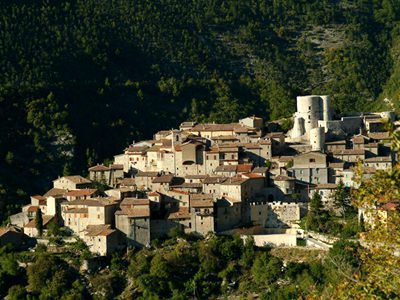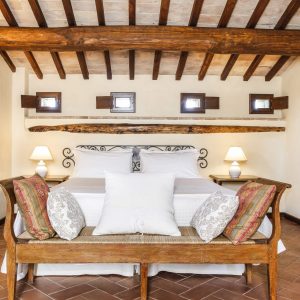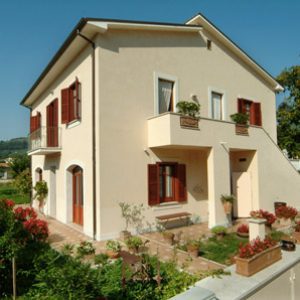▌ Alla scoperta di Polino
#BELLAUMBRIA
{“translation”:[{“lang”:”it”,”content”:”
Polino, anticamente Pulino, ubicato a quota 836 metri s.l.m deve il suo nome agli antichi feudatari del luogo. Successivamente feudo dell’antica famiglia ternana Castelli, venne utilizzato come roccaforte, grazie alla sua posizione tipicamente arroccata.
>>Vuoi vedere Polino? Consulta ora le offerte dei migliori hotel nelle vicinanze.
Giungendo alla piazza principale, denominata G. Marconi, colpisce l’antica porta del paese, ed accanto a questa un vecchissimo torrione che serviva come ufficio doganale e sede della milizia. Munito di una doppia cinta di mura, e sovrastato dalla rocca con torri cilindriche, il tessuto urbano mantiene numerose vestigia dell’originario. Tra i munumenti di rilievo presenti in questo borgo medioevale, bisogna annoverare il Castello che, serrato tra il Monte Petano e le propaggini del Monte La Pelosa, ebbe notevole importanza nell’ambito dell’area gravitante verso nord-est su Monteleone di Spoleto e verso sud-est su Rieti Un altro monumento di grande rilievo architettonico è la Fontana, eretta nel 1625 dal Marchese Castelli, conte di Collestatte e Torre Oesina, governatore perpetuo di Polino in stile tardo manieristico romano.

>> Ci sono offerte in scadenza per agriturismi nella zona di Polino! Clicca e consultale subito.
Notevole è pure la chiesa dedicata:”Amore Dei tempo del Rev.do Don Antonio Arroni Rettore 1575″. Uscendo dall’abitato si può ammirare un vasto panorama e salendo verso monte si può spaziare con lo sguardo a sud-est verso Greccio, il lago di Piediluco, Rieti e Leonessa; a nord-est verso Monteleone di Spoleto; a nord verso il Salto del Ciedo con i magnifici Monte Aspra e Monte Coscerno e si ha la possibilità di dominare con lo sguardo quasi tutta la Valnerina. Numerose e molto belle sono le passeggiate cui possono approfittare gli amanti del trekking. Sono anche disponibili una pista di sci da fondo di 5 km e alcune piste da sci da discesa ottime per i principianti. Tra le manifestazioni sono da ricordare l’Estate Polinense, nella terza domenica di Agosto, e la Festa della Castagna, nell’ultima settimana di Ottobre.
“},{“lang”:”en”,”content”:”Polino, originally called Pulino, is situated at 836 metres above sea-level and owes its name to antique regional fiefs. Later on, it became fief of the old Terni family of Castelli and was used as a strong-hold because of its typical placement on a rocky summit.
On reaching the main square called “G. Marconi”, the old town portal catches the eye, and next to it, a very old tower which used to be the customs-house and army seat. The urban structure, which has a double belt of town walls and whose rock is surmounted by cilindrical towers, has preserved much of the original structure. Among the important monuments to be found in this medieval town, the Castle which, closed in between the Petano and the La Pelosa mountains, and which was of noteworthy importance for the area reaching to the north-east to Monteleone of Spoleto and to the south-east to Rieti, should be named. Another monument of great architectonic importance is the Fountain, which was ercted in 1625 by the Marquis Castelli, Count of Collestatte and Torre Orsina and perpetual governour of Polino in the last manieristic Roman style.
The church, with its dedication: “Amore Dei tempo del Rev.do Don Antonio Arroni Rettore 1575″, is also noteworthy. Leaving the inhabited part of the town, one can admire a vast panorama, and going up in the direction of the mountain one can sweep ones’ eyes over to the south-east to Greccio, to Piediluco lake, and to Rieti e Leonessa; towards the north-east to Monteleone of Spoleto; towards the north to ” Salto del Ciedo” with the magnificent Aspra and Coscerno Mountains; further, one can see nearly all the Valnerina valley. The walks, perfect for trecking fans, are numerous and very beautiful. A ski run for cross-country skiing of 5 km and several ski runs for downhill-skiing perfect for beginners are also available. Among the shows figure the “Polino Summer”held during the last Sunday of August, and the “Feast of the Chestnut”, which takes place during the last week of October.
“},{“lang”:”es”,”content”:”Polino, originally called Pulino, is situated at 836 metres above sea-level and owes its name to antique regional fiefs. Later on, it became fief of the old Terni family of Castelli and was used as a strong-hold because of its typical placement on a rocky summit.
On reaching the main square called “G. Marconi”, the old town portal catches the eye, and next to it, a very old tower which used to be the customs-house and army seat. The urban structure, which has a double belt of town walls and whose rock is surmounted by cilindrical towers, has preserved much of the original structure. Among the important monuments to be found in this medieval town, the Castle which, closed in between the Petano and the La Pelosa mountains, and which was of noteworthy importance for the area reaching to the north-east to Monteleone of Spoleto and to the south-east to Rieti, should be named. Another monument of great architectonic importance is the Fountain, which was ercted in 1625 by the Marquis Castelli, Count of Collestatte and Torre Orsina and perpetual governour of Polino in the last manieristic Roman style.
The church, with its dedication: “Amore Dei tempo del Rev.do Don Antonio Arroni Rettore 1575″, is also noteworthy. Leaving the inhabited part of the town, one can admire a vast panorama, and going up in the direction of the mountain one can sweep ones’ eyes over to the south-east to Greccio, to Piediluco lake, and to Rieti e Leonessa; towards the north-east to Monteleone of Spoleto; towards the north to ” Salto del Ciedo” with the magnificent Aspra and Coscerno Mountains; further, one can see nearly all the Valnerina valley. The walks, perfect for trecking fans, are numerous and very beautiful. A ski run for cross-country skiing of 5 km and several ski runs for downhill-skiing perfect for beginners are also available. Among the shows figure the “Polino Summer”held during the last Sunday of August, and the “Feast of the Chestnut”, which takes place during the last week of October.
“},{“lang”:”de”,”content”:”Polino, originally called Pulino, is situated at 836 metres above sea-level and owes its name to antique regional fiefs. Later on, it became fief of the old Terni family of Castelli and was used as a strong-hold because of its typical placement on a rocky summit.
On reaching the main square called “G. Marconi”, the old town portal catches the eye, and next to it, a very old tower which used to be the customs-house and army seat. The urban structure, which has a double belt of town walls
and whose rock is surmounted by cilindrical towers, has preserved much of the original structure. Among the important monuments to be found in this medieval town, the Castle which, closed in between the Petano and the La Pelosa mountains, and which was of noteworthy importance for the area reaching to the north-east to Monteleone of Spoleto and to the south-east to Rieti, should be named. Another monument of great architectonic importance is the Fountain, which was ercted in 1625 by the Marquis Castelli, Count of Collestatte and Torre Orsina and perpetual governour of Polino in the last manieristic Roman style.
The church, with its dedication: “Amore Dei tempo del Rev.do Don Antonio Arroni Rettore 1575″, is also noteworthy. Leaving the inhabited part of the town, one can admire a vast panorama, and going up in the direction of the mountain one can sweep ones’ eyes over to the south-east to Greccio, to Piediluco lake, and to Rieti e Leonessa; towards the north-east to Monteleone of Spoleto; towards the north to ” Salto del Ciedo” with the magnificent Aspra and Coscerno Mountains; further, one can see nearly all the Valnerina valley. The walks, perfect for trecking fans, are numerous and very beautiful. A ski run for cross-country skiing of 5 km and several ski runs for downhill-skiing perfect for beginners are also available. Among the shows figure the “Polino Summer”held during the last Sunday of August, and the “Feast of the Chestnut”, which takes place during the last week of October.
“},{“lang”:”fr”,”content”:”Polino, antiquement Pulino, situé à 836 mètres d’altitude, doit son nom aux antiques propriétaires terriens de l’endroit. Propriété ensuite de l’antique famille de Terni les Castelli, le village est utilisé comme château fort, grâce à sa position typiquement accroché à la roche.
Arrivé à la place principale, appelée G. Marconi, on est étonné par l’antique porte du village, et à côté de cette dernière un très vieux donjon qui servait de bureau de douane et siège de la milice. Muni d’une double ceinture de murailles, et surplombé par le château avec trois tours cylindriques, l’ensemble urbain garde de nombreux vestiges du village d’origine.
Parmi les monuments importants présents dans ce village médièval, il faut souligner le Château qui, coincé entre le Mont Petano et les contreforts du Mont La Pelosa, il a eu une grande importance sur la zone gravitant vers le nord-est sur Monteleone di Spoleto et vers le sud-est sur Rieti. Un autre monument de grand relief architectonique est la Fontaine, construite en 1625 par le Marquis Castelli, comte de Collestatte et Torre Oesina, gouverneur perpétuel de Polino dans un style maniériste romain tardif. Est également remarquable l’église dédiée:”Amour des Temps du Révérend Don Antonio Arroni Rettore 1575″.
En sortant du village on peut admirer un vaste panorama et en remontant vers le mont on peut balayer du regard au sud-est vers Greccio, le lac de Piediluco, Rieti et Leonessa; au nord-est vers Monteleone di Spoleto; au nord vers le Saut du Ciedo avec ses magnifiques Mont Aspra et Mont Coscerno et il existe la possibilité de dominer du regard presque toute la Valnerina.
Nombreuses sont les promenades possibles, très belles, dont pourront profiter les amoureux du trecking. Sont également disponibles une piste de ski de fond de 5 km et quelques pistes de ski alpin excellentes pour les débutants.
Parmi les manifestations il faut rappeler L’Eté de Polino, le troisième dimanche d’août, et la Fête de la Châtaigne, la dernière semaine d’Octobre.
“}]}







